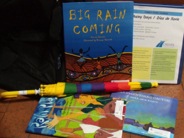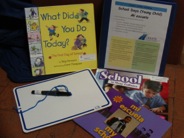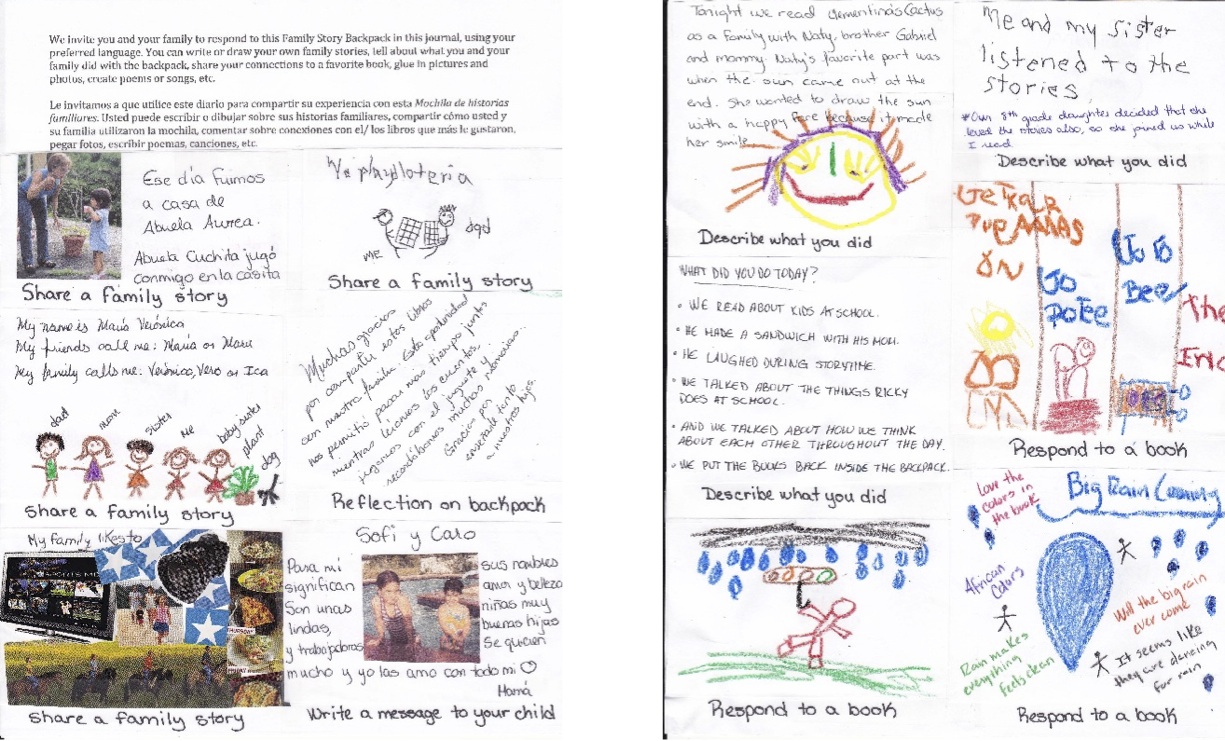by Kathy G. Short
 The oral stories that are shared in families both reflect and build on family funds of knowledge, providing a potential connection for meaningful home/school partnerships. At Worlds of Words, we have been exploring family story backpacks as a way to connect with families. Typically, the materials we send home from school tell parents how to do school with their child rather than encouraging them to share their stories and knowledge with us—we want to bring the home into school rather than just take school into the home. These backpacks are part of a larger project to redesign early childhood teacher education called CREATE – Communities as Resources for Early Childhood Teacher Education.
The oral stories that are shared in families both reflect and build on family funds of knowledge, providing a potential connection for meaningful home/school partnerships. At Worlds of Words, we have been exploring family story backpacks as a way to connect with families. Typically, the materials we send home from school tell parents how to do school with their child rather than encouraging them to share their stories and knowledge with us—we want to bring the home into school rather than just take school into the home. These backpacks are part of a larger project to redesign early childhood teacher education called CREATE – Communities as Resources for Early Childhood Teacher Education.
The theoretical frame of our work is based in funds of knowledge and story as a way of making meaning from our experiences. Stories are the way our minds make sense of our lives and world. We work at understanding events and people by constructing stories to interpret what is occurring around us. In turn, these stories create our views of the world and the lens through which we construct meaning about ourselves and others. The ways in which we create and tell stories are culturally-based, and so our stories are always interwoven with the stories that exist within our own cultures both in content and in the style and structure of the telling. These stories thus reveal a family’s values and funds of knowledge.
 The family story backpacks are a transportable curriculum designed to facilitate the sharing of stories within families. We developed 9 different backpacks around themes significant to families such as bedtime rituals, the origin of names, birthday traditions, and play. The backpacks have been used in early childhood and K-2 classrooms with each classroom receiving 6 different backpacks. 4-6 backpacks are rotated among the families in that classroom on a weekly basis. The backpacks each contained 3 books (1 informational concept book and 2 picture book stories), a related artifact, and a family story journal. The purpose of the artifact is to encourage families to share oral stories around the theme. They are encouraged to share their stories and experiences with the backpack in the family story journal. We have developed a range of forms, letters home, journal sheets, and book lists that are available for teachers who want to explore these backpacks in their own settings.
The family story backpacks are a transportable curriculum designed to facilitate the sharing of stories within families. We developed 9 different backpacks around themes significant to families such as bedtime rituals, the origin of names, birthday traditions, and play. The backpacks have been used in early childhood and K-2 classrooms with each classroom receiving 6 different backpacks. 4-6 backpacks are rotated among the families in that classroom on a weekly basis. The backpacks each contained 3 books (1 informational concept book and 2 picture book stories), a related artifact, and a family story journal. The purpose of the artifact is to encourage families to share oral stories around the theme. They are encouraged to share their stories and experiences with the backpack in the family story journal. We have developed a range of forms, letters home, journal sheets, and book lists that are available for teachers who want to explore these backpacks in their own settings.
When the child brings the backpack back to the classroom, the child is given time to share how the family interacted with the backpack and to read or show their entries in the journal. The sharing has sometimes occurred in a whole class meeting and other times in a small group with the teacher and other children who took home a backpack that week. In several neighborhood schools where teachers start the day with a class meeting, parents and grandparents have joined the sharing on the day the child brings back a backpack from their home. The backpacks are then sent home for a week with another group of children. The journals stay with the backpacks so that each family can read the previous entries.
Families have made a range of entries in the journals that include drawings, photographs, and written stories by various family members in different languages that focus on:
•Descriptions of what the families did with the backpacks
•An account of the day (recounting of what I did today)
•Responses to the books in the form of retellings and “I like” statements, personal connections to the books, and personal connections that developed into family stories
•Telling a family story from the past or present or creating a list of family stories.
•Love letters (parent to child, child to family members)
•Appreciation notes to teacher
In their entries, families have explored:
•Sharing a memory from the past with the child
•Reminding the family of a memory that they share
•Creating a new memory through interactions around the backpack
•Reminder of the values and cultural heritage shared by the family
•Provided multiple options for interacting with the books, artifacts, and story so that families are not constrained by school definitions of literacy
 The journals have provided teachers with insights about:
The journals have provided teachers with insights about:
•Interactions around literacy (Who read and writes with the child and the literacy practices and knowledge in the family)
•Fluency in multiple languages across family members
•Household knowledge and values
•Cultural identity of family
•Family relationships and interactions (ways in which families relate and enjoy time together and the role of fathers and of extended family members).
As teachers learn more about the knowledge that children bring to school, they are able to understand that children and their families are resources for the classroom, thus challenging deficit views of children and families. The pressures of “doing school” and teaching children to read can so overwhelm the attention of teachers that they do not pay attention to the rich sources of funds of knowledge available in families. The family journals encourage new insights and a greater valuing of family experiences. Teachers feel a stronger sense of relationship and more personal knowing of families that influences their perspectives of those families. The backpacks provide families with encouragement to share their stories and to create new stories. If these stories are valued in classrooms, they can become the basis for stronger relationships and partnerships between families and schools as well as for constructing curriculum that connects to children’s experiences and cultures.
Journey through Worlds of Words during our open reading hours: Monday-Friday, 9 a.m. to 5 p.m. and Saturday, 9 a.m. to 1 p.m. To view our complete offerings of WOW Currents, please visit archival stream.
- Themes: Kathy Short
- Descriptors: Books & Resources, WOW Currents
